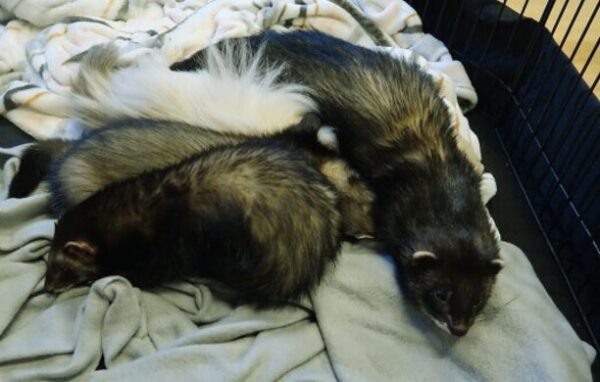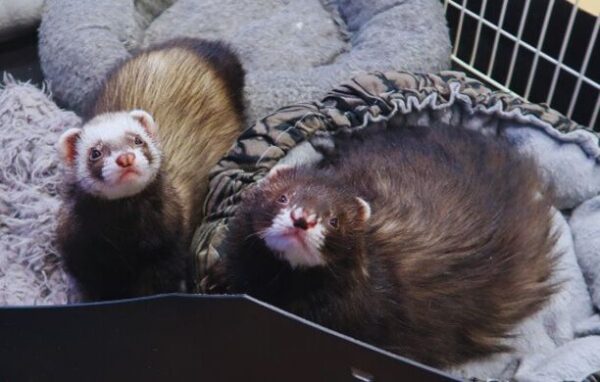In this post, you will learn about the Angora ferret: everything you need to know about this special ferret.
An Angora ferret isn’t the same as a standard ferret. They are a more fluffy, playful, and exciting ferret breed.
Also, many people aren’t aware of this breed or type of ferret. If you are among them, then you will be glad to know here I will guide you through everything you need to know about Angora Ferret.
So, make sure to read till the end to know everything about the special Angora ferret.
Content List
- 1 What is an Angora Ferret?
- 2 Origin and History of Angora Ferret
- 3 Total Types of Angora ferrets
- 4 Angora Ferret Health Problems and Concerns
- 5 Angora Ferret Diet
- 6 Where Can I Buy an Angora Ferret?
- 7 Can You Get Angora Ferrets in the US?
- 8 Is Angora’s Fur Banned?
- 9 Angora ferret Color
- 10 Are Angora Ferrets Rare?
- 11 Angora Ferret vs Standard ferret
- 12 What are Some Interesting Facts About Angora Ferrets?
- 13 Frequently Asked Questions (FAQs)
- 14 Conclusion
What is an Angora Ferret?
Angora is another type of ferret and they are different from a standard ferret. They have more long and shiny fur than standard ones.
Another key difference is that the Angora ferret is a long-haired ferret and their fur is three times more than we already know of.

The angora ferret’s hair is usually between two to eight inches long. To grow its coat to maximum length it took up to several years.
What made this ferret unique and more special is the availability of the undercoat, which is almost the same length as the guard lengths of the Angora ferret.
These long or shield hairs protect Angora ferrets from undesired water and dust. Angora ferret also goes through the molting process every year which results in some hair fall in the autumn and summer seasons.
Their coat or hair is longer in winter and shorter in summer but, it’s longer than usual for ferrets in both summer and winter.
Origin and History of Angora Ferret
Angora ferret originated in the Scandinavian region of Europe, precisely it was in Norway. A Swedish ferret breeder noticed some extra hair length on the back side of some ferrets.
The breeder sold these ferrets to a breeder from Norway who was impressed with the extra-grown hair quality. It was then this breeder decided to combine ferrets with longer fur to breed offspring with longer fur.
Angora ferrets have been around for nearly 25-30 years which is why they are considered a new ferret type. Due to their lesser time or origination, they are unknown to many pet lovers.
Angora ferrets belong to the Mustelidae family and Mustela furo is their scientific name. Angoras are found in Europe and North America.
Total Types of Angora ferrets
Although, the Angora ferret originated from standard or regular ferrets, but their popularity among ferret lovers is increasing drastically.

Thanks to the angora ferret’s shiny fur and unique coat and long hair which earned them extra attention. Over three decades, Angora ferrets have been classified into four types, which are given below:
Full angora ferret
With its name, it’s clear that full Angora is the ferret consisting of 100% Angora genees. This is the source for all other types of Angora ferrets.
Full angora has the longest hair among all other angora types, with minimal difference between the top and undercoat. This type of angora ferret is highly popular among ferret owners.
Semi angora ferret
As its name suggests this is not a pure form of Angora due to which it’s largely known as 3/4 ferrets. Semi-angora has decent fur but less than a full one.
Semi-angora has a shorter undercoat as compared to the full Angora. The nose of this type of ferret is as same as standard or regular ferret.
Half angora ferret
You can understand from the name that it contains half the characteristics of Angora ferret. Half Angora is born through the mating of an Angora ferret and a standard ferret.
The fur of half Angora is shorter than Semi and full Angora. But, their nose is the same as the standard ferret.
Part angora ferret
Part Angora are those ferrets that consist of a part of the Angora ferrets. The containing part would be less than half of Angora and could be up to very less. Due to this, they are more standard than Angora ferret.
They have fluffy fur but very little and it is nothing compared to Full Angora ferrets. But, there are some exceptions and some Part Angora might have a beautiful long coat
Angora Ferret Health Problems and Concerns
Like in any pet animal, the desired breeding increases the number of any particular type, and the same goes with Angora ferrets as well.

An angora ferret mating can be performed in various combinations for your desired types. And in the process of mating or breeding, there come several health issues.
Below, mention some of the most common health problems in Angora ferrets. You should be aware of them even before owning an Angora ferret.
Unusual nose folds
Unusual nose fold problems are majorly found in Pure Angoras. In this, the nose of the Angora ferret grows a bit more and in folded form. This makes it less attractive to Angora ferrets.
Due to extra-length nose folds, the growing hair in the nose creates breathing problems for the angora ferret. However, it’s also true that not all Pure Angora ferrets have these unusual nose folds.
Limited nursing period
Most of the female Angora ferrets face limited nursing periods due to which they cannot nurse their kids efficiently.
The problem arises after the birth of kids, during this the milk production of female angora got limited or even dried up completely. Mother milk is the only food for angora kids until they grow a certain age.
The shortage of milk by female ferrets causes some serious health problems for the kids. Even in some cases, kids die due to the absence of mother milk.
Angora Ferret Diet
Like any other ferret, the Angora ferret is also a carnivorous animal, which means they will eat meat as their primary food. Angora ferret food should be high in protein and limited in carbohydrates.
They can eat both cooked and raw food but in the required amount. Angora ferrets enjoy cooked chicken and turkey.
Due to their carnivore nature, Angoras are also a great hunter, they easily catch rabbits, mice, and rats.
Where Can I Buy an Angora Ferret?
Before buying you should know everything about Angora ferret. You should be well aware of Angora’s diet, type, health, care, food, and more.

You can buy Angora ferrets both online and from a local breeder at your location.
There is one thing more special about Angora ferrets and it’s their type. Unlike other ferrets, Angora is of four types Pure Angora, Semi Angora, Half Angora, and Part Angora.
By visiting this website you can buy the Angora ferret of your desired type. If your desired ferret isn’t available then check after some time and you will find it.
Can You Get Angora Ferrets in the US?
Yes, you can get Angora ferrets in the US. But, in some places in the United States like Hawaii and California any kind of ferret is banned.
So, before owning an Angora ferret you should check for legal rules at your location.
Since the creation of the Angora ferret, it started getting attention and acceptance from pet owners. Soon angora pets became part of families in Europe and the United States.
Is Angora’s Fur Banned?
In 2021, after a huge protest against animal brutality. Finally, many giant brands announced to stop using Angora’s fur and rabbit for their product.
Brands like Gucci, the Bottega Veneta, Balenciaga, Saint Laurent, and Alexander McQueen parent said they will no longer source Angora.
Angora ferret Color
Along with other similarities angora ferrets also share the same color type and pattern as a standard ferret.
So, the angora ferret is found in sable (black and dark), chocolate, cinnamon, bibbed, solid, and more.
Are Angora Ferrets Rare?
Yes, Angora ferrets are rare. Angoras have indeed gained immense acceptance from pet lovers in recent years. But, getting a pure angora ferret is still a big challenge.
Due to this challenge, the prices of angora ferret are usually higher than a standard ferret. If you are ready to face challenges and pay the price then you can contact several breeders.
Angora Ferret vs Standard ferret
Both Angora and standard are ferrets and except for fur length and nose shape these ferrets are the same.
Angora ferrets and standard ferrets both are carnivores in nature. Both are socially active and attention-seeking pet ferrets.
Angora ferrets are capable of killing their prey, like rats, cats, mice, and more, like a standard ferret does. Both have the same kind of health issues, care, and attention.
So, if you are looking for an Angora ferret, keep in mind that this ferret type is limited. Due to this, their price is a bit higher than standard ferret so make sure you have budgeted accordingly.
What are Some Interesting Facts About Angora Ferrets?
Mentioning interesting facts about Angora ferrets. Some of the facts might amaze you but, for sure you get some new insight before owning an Angora ferret.
- Angora ferret was created or discovered accidentally.
- Angora ferret was discovered nearly 30 years ago.
- They are extremely friendly and seek to go out. They intend to gain attention and they don’t show aggressiveness.
- Scientifically they aren’t categorized as different species from ferrets, instead, they are declared as one of the types of ferrets.
- It took many years for the Angora Ferret to become a home pet after its creation.
Frequently Asked Questions (FAQs)
How long do Angora ferrets live?
On average angora ferrets live 5-9 years.
Do Angora ferrets smell?
Yes, angora ferrets exhibit a musky smell.
Does Angora fur grow back?
Yes, Most breeds of Angora rabbits moult with their natural growth cycle about every four months.
What is the smallest Angora breed?
The English Angora is the smallest angora breed.
Conclusion
By now, you know everything about Angora Ferrets. Angora ferrets have higher, light fur, which makes them look better as compared to standard ferrets. So, you can own an Angora ferret.
An angora ferret needs the same quality and quantity of food, shelter, care, and affection.
